Related Research Articles

Benjamin Franklin Thorne was an American comic book artist-writer, best known for the Marvel Comics character Red Sonja.

An American comic book is a thin periodical originating in the United States, on average 32 pages, containing comics. While the form originated in 1933, American comic books first gained popularity after the 1938 publication of Action Comics, which included the debut of the superhero Superman. This was followed by a superhero boom that lasted until the end of World War II. After the war, while superheroes were marginalized, the comic book industry rapidly expanded and genres such as horror, crime, science fiction and romance became popular. The 1950s saw a gradual decline, due to a shift away from print media in the wake of television and the impact of the Comics Code Authority. The late 1950s and the 1960s saw a superhero revival and superheroes remained the dominant character archetype throughout the late 20th century into the 21st century.

Steve Canyon is an American adventure comic strip by writer-artist Milton Caniff. Launched shortly after Caniff retired from his previous strip, Terry and the Pirates, Steve Canyon ran from January 13, 1947, until June 4, 1988. It ended shortly after Caniff's death. Caniff won the Reuben Award for the strip in 1971.

Tom Feelings was an artist, cartoonist, children's book illustrator, author, teacher, and activist. He focused on the African-American experience in his work. His most famous book is The Middle Passage: White Ships/Black Cargo.
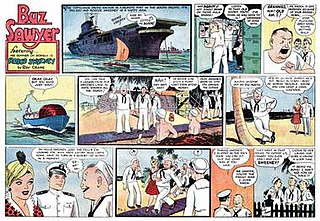
Buz Sawyer is a comic strip created by Roy Crane. Distributed by King Features Syndicate, it had a run from November 1, 1943 to October 7, 1989. The last strip signed by Crane was dated 21 April 1979.

Arthur Burdett Frost, usually cited as A. B. Frost, was an American illustrator, graphic artist, painter and comics writer. He is best known for his illustrations of Brer Rabbit and other characters in the Joel Chandler Harris' Uncle Remus books.

Richard W. Sprang was an American comic book artist and penciller, best known for his work on the superhero Batman during the period fans and historians call Golden Age of Comic Books. Sprang was responsible for the 1950 redesign of the Batmobile and the original design of the Riddler, who has appeared in film, television and other media adaptations. Sprang's Batman was notable for his square chin, expressive face and barrel chest.
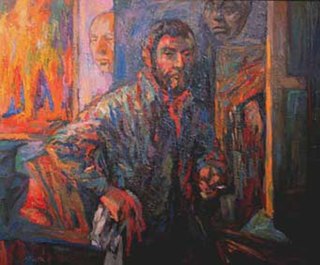
Bernard Krigstein was an American illustrator and gallery artist who received acclaim for his innovative and influential approach to comic book art, notably in EC Comics. His artwork usually displayed the signature B. Krigstein. His best-known work in comic books is the eight-page story "Master Race", originally published in the debut issue of EC Comics' Impact.

Major Malcolm Wheeler-Nicholson was an American pulp magazine writer and entrepreneur who pioneered the American comic book, publishing the first such periodical consisting solely of original material rather than reprints of newspaper comic strips. Historian and author David Hajdu credits Wheeler-Nicholson as "the link between the pulps and what we know of as comics today." And launching the magazine comics company National Allied Publications in 1934, which would evolve to become DC Comics' later on. He was a 2008 Judges' Choice inductee into the Will Eisner Comic Book Hall of Fame.
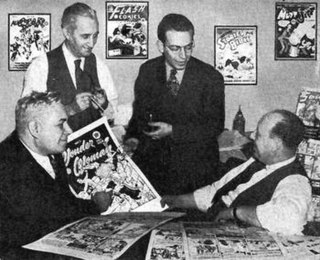
Harry George Peter was a French-American newspaper illustrator and cartoonist known for his work on the Wonder Woman comic book and for Bud Fisher of the San Francisco Chronicle.
Kerry G. Johnson is an African-American cartoonist, graphic designer, art director, caricaturist and children's book illustrator. He specializes in caricatures but has created cartoons, illustrations and news graphic work in his career in news and publication design.
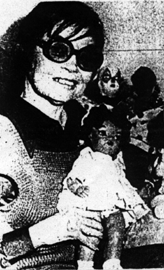
Jackie Ormes was an American cartoonist. She is known as the first African-American woman cartoonist and creator of the Torchy Brown comic strip and the Patty-Jo 'n' Ginger panel.
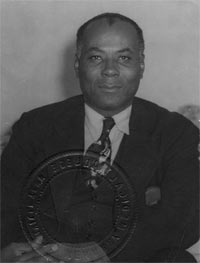
Robert Walter "Whirlwind" Johnson was an American physician, college football player and coach, and founder of the American Tennis Association Junior Development Program for African-American youths, where he coached and fostered the careers of Arthur Ashe and Althea Gibson.
The Pittsburgh Courier was an African American weekly newspaper published in Pittsburgh from 1907 until October 22, 1966. By the 1930s, the Courier was one of the leading black newspapers in the United States.

Shield–Wizard Comics was the name of an American comic book series published by MLJ Magazines Inc., more commonly known as MLJ Comics, for thirteen issues between Summer 1940 and Winter 1944.
Bill Murray is an American cartoonist.
The history of American comics began in the 19th century in mass print media, in the era of sensationalist journalism, where newspaper comics served as further entertainment for mass readership. In the 20th century, comics became an autonomous art medium and an integral part of American culture.
Elton Clay Fax was an American illustrator, cartoonist, and writer.

Juanita Hamel Early Fowle was an American artist and writer whose syndicated stories and illustrations appeared in newspapers across the United States in the 1910s and 1920s.
Superman: The Complete Comic Strips 1939-1966 is an unofficial umbrella name for the six following titles: Superman: The Golden Age Dailies, Superman: The Golden Age Sundays; Superman: The Atomic Age Dailies, Superman: The Atomic Age Sundays; Superman: The Silver Age Dailies and Superman: The Silver Age Sundays, all published by The Library of American Comics. These six series of books collects the complete run of the American comic strip Superman by DC Comics, which was originally distributed in newspapers by the McClure Syndicate between 1939 and 1966.
References
- ↑ Congress, The Library of. "LC Linked Data Service: Authorities and Vocabularies (Library of Congress)". id.loc.gov.
- 1 2 3 "Catalog". www.pulpartists.com.
- ↑ "Edd Ashe". lambiek.net.
- ↑ Jackson, Tim (April 21, 2016). Pioneering Cartoonists of Color. Univ. Press of Mississippi. ISBN 9781496804808 – via Google Books.
- ↑ Mougin, Lou (10 January 2020). Secondary Superheroes of Golden Age Comics. McFarland. ISBN 9781476638607.
- ↑ "Vintage Black Heroes - Guy Fortune | The Museum Of UnCut Funk". museumofuncutfunk.com.
- ↑ "1 Jan 1955, Page 31 - The Pittsburgh Courier at Newspapers.com". Newspapers.com.